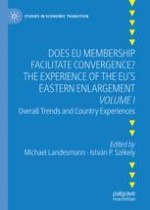This edited volume analyses how EU membership influenced the convergence process of member countries in the Baltics, Central-Eastern and South-Eastern Europe. It also explores countries that are candidates for future EU membership. The speed of convergence of significant groups of low- and medium-income countries has never been as fast globally as it is today. Contributions by lead researchers of the area explore whether these countries are converging faster than their fundamentals and global trends would suggest because of EU membership, with its much tighter institutional and political anchorage
